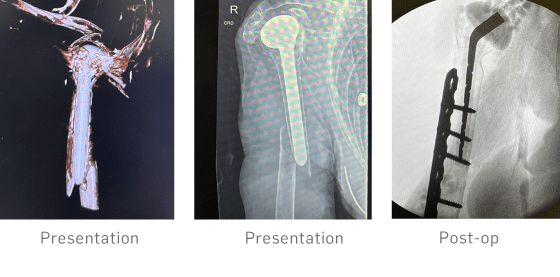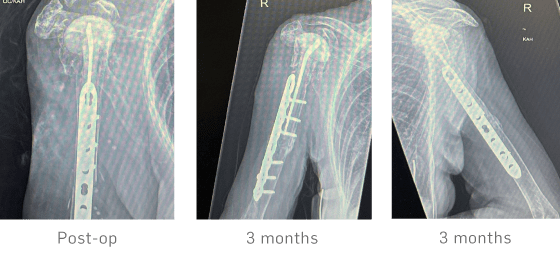

Clinical history
An 82-year-old female presented following a fall, sustaining a right humerus periprosthetic fracture. The patient reported pain, reduced shoulder mobility, but intact neurovascular status. X-ray imaging revealed an oblique periprosthetic fracture at the tip of the implant stem, without signs of loosening. The patient had previously undergone a right hemiarthroplasty over 20 years ago. Imaging also indicated rotator cuff failure, severe superior migration of the humeral head, and glenoid erosion with medialization. Prior to the fall, the patient had been pain-free but had limited shoulder range of motion.
Treatment
The existing hemiarthroplasty was removed, and samples were taken to exclude a potential low-grade infection. The fracture was stabilised using a large fragment plate in compression mode. Notably, periprosthetic fractures around the tip of a well-fixed press-fit stem present a significant challenge due to the limited bone stock available for secure screw fixation in the proximal segment. This increases the risk of delayed union or non-union, as well as potential hardware loosening. To address these concerns, a H40 SYNICEM shoulder spacer was inserted as a temporary measure in place of the hemiarthroplasty; this allowed better purchase of the screws in the proximal fragment and so more stable fixation which lead to early healing of the fracture. Plans for a possible future second-stage revision surgery to a reverse total shoulder arthroplasty are also now possible. 10cc of STIMULAN mixed with antibiotic was applied intra-operatively.
Outcome
At the 3-month follow-up, X-rays demonstrated complete absorption of the STIMULAN beads and successful healing of the fracture, with the SYNICEM spacer remaining in position. Clinically, the patient remained pain-free and neurovascularly intact, with no signs of infection.
The patient is now eligible for a second-stage procedure if shoulder function becomes a concern in the future.
Note: See SYNICEM page for regulatory statements. MA0506R1
Listed below are 4 of the most relevant articles for this piece but there is much more to explore on our Library page.
Explore Library